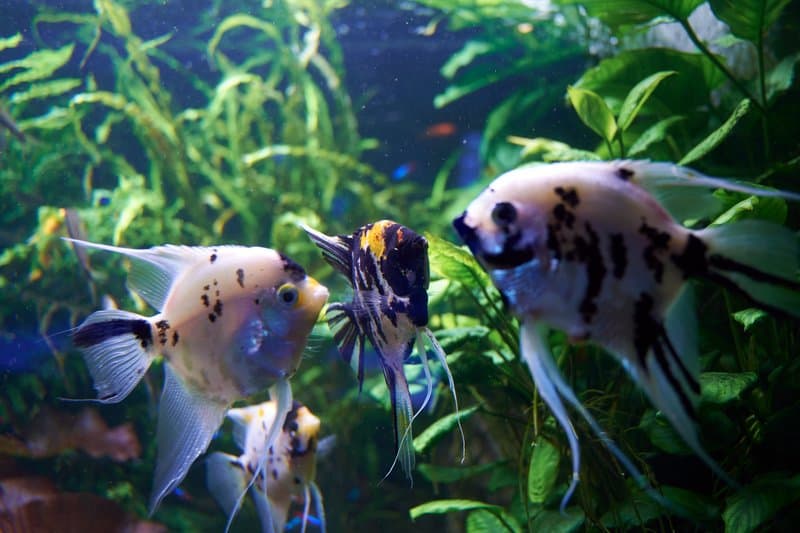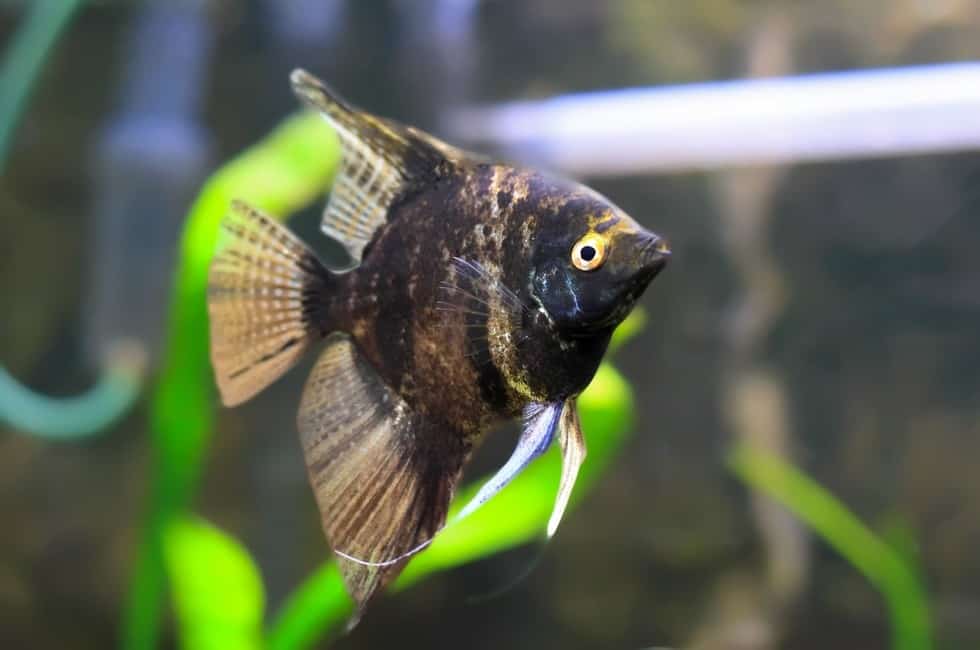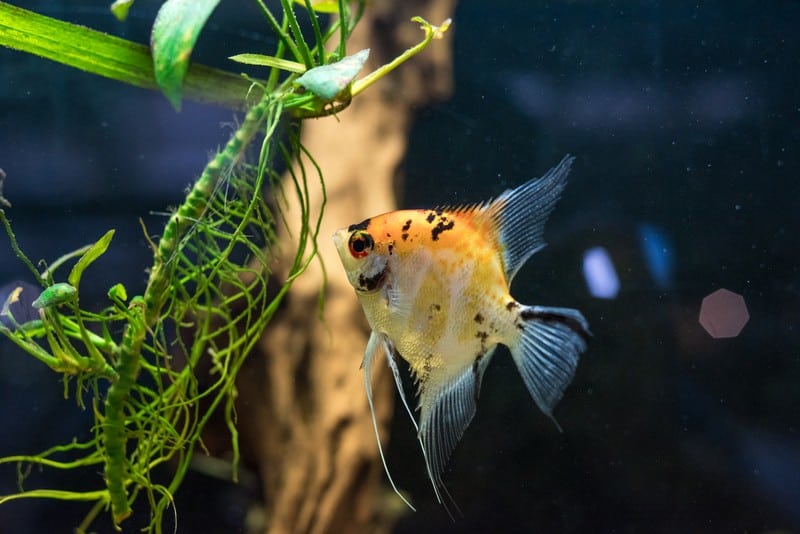Angelfish are a very popular species of the aquarium that have drawn a lot of interest and attention by aquarists. Due to its unique characteristics and features, many people have found it an interesting type of aquarium fish to both studies and keep. In fact, the nature of the angelfish requires that you understand it well before you can successfully keep them in your fish tank.
Are Angelfish Aggressive? Angelfish tend to display traits of aggression amongst other fish. Being an active, feisty species, they usually exhibit an aggressive and territorial nature and are not usually very friendly tank mates. Thus, it requires a lot of caution and understanding to keep angelfish.
Facts about keeping Angelfish
They are a freshwater species of fish from the Cichlid family, and they originally came from freshwater Amazon River in South America before becoming common in home aquariums.
Keepers of community aquariums often ask if the nature of the angelfish supports aquarium keeping because they have been known to naturally exhibit some traits of aggression.
Angelfish are actually fun to keep, and their active nature is known to bring life to any aquarium. However, they might not be very easy to keep for beginners because they have an aggressive nature.
Also, as carnivorous fish that enjoy live foods, pellet foods, flakes and some bit of plants, they display aggressive eating habits that make them a threat to other fishes, particularly small ones.
They are however not fussy and would require minimal attention for themselves. Angelfish are actually a beautiful kind of fish and they add color to any aquarium and thrive in many home fish tanks that are well taken care of.
When kept in favorable conditions, angelfish grow to about six inches and are even known to surpass the average length to reach about ten inches upon maturity. They usually prefer tall aquariums as against shallow but wide ones.
This can be said to be because of their long fins which get nipped at occasionally by other fishes. They have a considerably long lifespan; as they are known to live up to ten years if the conditions are comfortable and healthy.
Take note that male and female angelfish look very much the same. Unlike many other aquarium fishes that have a size and color difference in their males and females, angelfish are usually looking very much alike.
It is only during the breeding period that you might notice some slight difference in their papilla. This is however tricky to recognize for many beginners.
Why are angelfish usually aggressive?
Well, they are naturally territorial in nature. So aggression is how they communicate their hierarchy in the water. Sometimes it isn’t due to any specific issue, except that they need to establish themselves at the highest rank in the aquarium.
Although it has been observed that too frequent water changes have a way of upsetting the balance of their social ranking, hence they might need to re-establish their position after every water replacement.
This is done through their urine and other waste excrements that are done in the water. Changing the water usually nullifies the effect, causing a new, aggressive power tussle in the tank.
Another reason angelfish might display excessive aggression is if there is another equally aggressive type of fish competing with them. A pair of angelfish would attempt to subdue the others and would not agree with any other competitor(s). This is mainly why angelfish are usually kept as the only dominant fish in a community aquarium.
One more reason for angelfish aggression is an insufficient diet. Although they aren’t picky eaters, angelfish wouldn’t enjoy an environment where there is too much competition for food. If this happens, they would likely chase and eat other small fishes aggressively.
Furthermore, angelfish aggression might be more pronounced during their breeding period. Thus if you notice an increase in the aggression from what is usually, it might be a sign that your angelfish is ready to lay eggs.
How to Reduce Angelfish Aggression
Firstly, you should understand the nature of angelfish and simply let them behave as they naturally would. However, in case of excessive and uncontrollable aggression, you might get some solutions to reducing this from the reasons given above.
Changing the water less frequently might help you have a calmer tank, through the stability and balance in the set social ranking. However, this doesn’t mean you would keep a dirty tank, as this would further irritate them and endanger their health.
Also, taking out the breeding angelfish is a sure way to curb aggression, as well as maintaining a well-fed, healthy and suitable water condition. Angelfish can be less aggressive depending on how well they are taken care of, and the suitable tank mates also.
Are angelfish hardy?
Despite the fact that angelfish can be quite unfriendly, they are not very hardy, although they fed very well and are not too fussy.
However, when you consider that they require specific water conditions, with very clean and very large water tank, you might consider them a little more tasking than the average aquarium fishes. Their tank also requires proper filtering to ensure the survival of your angelfish.
More: How Long Do Angelfish Live?
They are also very prone to some fish diseases such as Ich which can be spread to other fishes in the tank and cause you some problem.
In addition, they are not the most agile swimmers and would not survive in a tank with a high current. They also don’t do well in a crowded tank, or in poor water conditions.
In addition, they don’t appreciate noisy surroundings at all and can even die from sudden, loud noise. Hence they are regarded as not being quite hardy.
Are angelfish aggressive with each other?
Many keepers of angelfish agree that they are best kept with their own kind. Since there are varieties of angelfish due to crossbreeding, angelfish of different varieties may be kept together.
Note also that intense aggression mainly only occurs when there is an issue with the living conditions. In very favorable conditions, with little competition for food amongst the fishes, aggression in angelfish can be highly reduced.
You should, however, be careful if you’re going to house your angelfish together in one aquarium. Asides the challenge of aggression, you should take note that there are freshwater angelfish, as well as saltwater or marine angelfish. Thus, it would be impossible to keep marine angelfish in a freshwater angelfish tank.
The marine angelfish are also very fascinating to keep. However, maintaining a saltwater tank might be a bit more difficult than maintaining a freshwater tank. Thus, freshwater angelfish are the most commonly kept in home aquariums.
Knowing that they originate from the family of Cichlids, it is only expected that they be naturally aggressive and pesky fighters. Angelfish develop a system of hierarchy in any tank and they fight to maintain a position amongst other angelfishes.
Should angelfish be kept in pairs?
Angelfish definitely do well in pairs. Angelfish are mostly known to pair off with one of their kind and go off together for breeding. Furthermore, if you put in a group of angelfish in one tank, pairs would soon be formed, which may take a dominant role in the tank towards the others.
In fact, angelfish are good tank mates when they are still young. It is only upon maturity that they begin to display aggression. So if you have small sized or young angelfish, you should be able to have a number of them live peacefully together.
Are Angelfish aggressive towards other fish?
Despite the aggressive nature of angelfish, they can, in many cases, live normally with other fishes. They are however usually the dominant fish in a tank and this means they would do what is natural to them.
Being cichlids, and thus aggressive waters, they might eat the small fry in the tank. Mostly, angelfish would pair off in twos or threes and chase other fishes in the aquarium.
Thus, you might want to have fish that are not too small, or they could become prey for the angelfishes. Having another type of aggressive fish asides your angels might be inadvisable if you don’t want your aquarium turned into a battlefield.
Seeing that angelfish can grow to up to about ten inches in size, they would naturally try to eat any fish small enough to enter their mouths.
More: Types of Cichlids That Can Live Together
Are angelfish easy to keep?
Looking at all the features of angelfish, many aquarists, especially beginners would find them somewhat difficult to handle. However, this is not entirely the case. If you fulfill all the necessary conditions in keeping them, they are actually quite easy to maintain.
What can live with angelfish?
Having a community tank with angelfish is not impossible at all. In fact, there are a good amount of fishes which would be suitable tank mates for your angelfish.
All you must ensure is that there are not too many of them who share an aggressive nature. Peaceful fishes can be kept in the same tank with angelfish. Some of these include;
- The dwarf gouramis,
- platies
- plecos
- swordtails
- some species of tetras such as lemon tetras
- Guppies
- Mollies
- Corydora catfish (in a school)
- Brittlenose plecos
- Keyhole cichlids
Be conscious of the fact that very docile fishes like the dwarf gourami might be easily bullied by angelfishes, but they would mostly stay out of the way of any threat.
More: Top 20 Angelfish Tank Mates
Guppies and mollies would also be compatible tank mates, as long as they are matured and not too small to be seen as a snack. Corydora catfishes in a group of four or five can also be kept in an angelfish tank. They are gentle, peaceful and good community fish.
It would be an advantage to keep fish that share water preferences with angelfish in the same tank. For instance, the bristle nose plecos are also known to originate from the Amazon River, just like angelfish.
They are however bottom swimmers who feed on algae in your fish tank. But if you know that your water would be kept sparkling clean because of your angelfish, you can still supplement the food the brittle nose plecos eat with flaky foods or other plants, and they would have no problems with angelfish.
In addition, you can keep other cichlids with your angelfish, particularly if they are not too big and aggressive as much as the angelfish. For example, the Keyhole Cichlid is known to be one of the most peaceful cichlids and would naturally not disturb the angelfishes.
Mostly, the compatible tank mates are really about getting fishes that can peacefully stay with a more dominating fish like the angelfish, and not about the ones that would harm angelfish.
The only issue is that the angelfish has long fins that might draw the curiosity of other bold fish which might attempt nipping at the long find, hence causing aggression.
While you need to be careful about some tetras and barbs staying with your angelfish, it is preferable you have them in a school, so as to prevent them from going after your angelfish.
The more peaceful, tolerant species of tetras that won’t try to eat at angelfish fins can be kept. Generally, it would be very beneficial to grow your angelfish from young, alongside other young fishes. That way, it wouldn’t be as aggressive or dominating as a full grown angelfish brought into the company of smaller fishes.
Some Tips For Keeping Angelfish
If you are a beginner, it might be difficult to get angelfish to be compatible with other fishes when they are breeding. Breeding angelfish show a higher degree of aggression than others. So it might be advisable to take away the breeding pair into a separate tank, for the safety of other fishes.
Furthermore, any fish more aggressive than angelfish is a big no-no for your angelfish tank. An example of this would be Kissing gourami.
While some other gourami species would do just fine, the kissing gourami, on the other hand, being equally very territorial, would start instantly pick on angelfish and vice versa.
Tiger barbs are also quite territorial and would not make suitable tank mates for angelfish. Also, goldfish and angelfish share some bit of contrasting natures that would make them non-compatible. This is because goldfish are known to produce a lot of waste matter and this would affect the hygiene of your angelfish.
In determining good community tank mates for your angelfish, it is important that you take the peculiarities of your water tank, as well as the nature of your individual fishes into consideration.
Being living organisms, some might display attributes that are uncharacteristic sometimes. Also, due to other factors, you might need to consider properly the kind of compatible tank mates that would be suitable for the survival and well-being of your angelfish.




